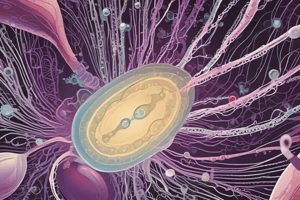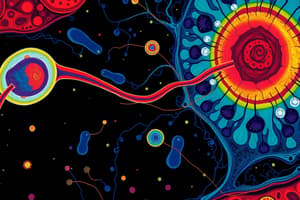Podcast
Questions and Answers
Which of the following cell types involved in spermatogenesis is responsible for producing testosterone?
Which of the following cell types involved in spermatogenesis is responsible for producing testosterone?
- Spermatogonia
- Sertoli Cells
- Leydig Cells (correct)
- Primary Spermatocytes
What is the role of follicle-stimulating hormone (FSH) in spermatogenesis?
What is the role of follicle-stimulating hormone (FSH) in spermatogenesis?
- Directly transforms spermatids into spermatozoa.
- Stimulates Sertoli cells to support spermatogenesis. (correct)
- Initiates meiosis in primary spermatocytes.
- Stimulates Leydig cells to produce testosterone.
During which stage of spermatogenesis does a diploid cell become a haploid cell?
During which stage of spermatogenesis does a diploid cell become a haploid cell?
- Transformation of spermatids into spermatozoa
- Differentiation of Leydig cells
- Meiosis I of primary spermatocytes (correct)
- Mitosis of spermatogonia
What is the primary function of Sertoli cells during spermatogenesis?
What is the primary function of Sertoli cells during spermatogenesis?
Which event occurs during spermiogenesis?
Which event occurs during spermiogenesis?
Inhibin provides negative feedback to regulate the production of which hormone?
Inhibin provides negative feedback to regulate the production of which hormone?
Approximately how long does the entire process of spermatogenesis take in humans?
Approximately how long does the entire process of spermatogenesis take in humans?
Which of the following factors can negatively impact spermatogenesis?
Which of the following factors can negatively impact spermatogenesis?
Which of the following is NOT a primary function of Sertoli cells within the seminiferous tubules?
Which of the following is NOT a primary function of Sertoli cells within the seminiferous tubules?
The blood-testis barrier is critical for protecting developing sperm from autoimmune attack. What forms this barrier?
The blood-testis barrier is critical for protecting developing sperm from autoimmune attack. What forms this barrier?
Azoospermia, a condition associated with male infertility, is characterized by which of the following?
Azoospermia, a condition associated with male infertility, is characterized by which of the following?
During which phase of meiosis I does crossing over occur, leading to genetic diversity?
During which phase of meiosis I does crossing over occur, leading to genetic diversity?
What is the primary function of the acrosome during fertilization?
What is the primary function of the acrosome during fertilization?
Which cellular component is primarily responsible for providing the driving force for sperm motility?
Which cellular component is primarily responsible for providing the driving force for sperm motility?
Why is it important for sperm to shed excess cytoplasm during their maturation?
Why is it important for sperm to shed excess cytoplasm during their maturation?
Sperm motility is affected by several factors. Which of the following pH conditions is most optimal for sperm motility?
Sperm motility is affected by several factors. Which of the following pH conditions is most optimal for sperm motility?
How does the pampiniform plexus contribute to temperature regulation in the testes?
How does the pampiniform plexus contribute to temperature regulation in the testes?
Reactive Oxygen Species (ROS) can have both beneficial and detrimental effects on sperm. What is a negative impact of high levels of ROS on sperm?
Reactive Oxygen Species (ROS) can have both beneficial and detrimental effects on sperm. What is a negative impact of high levels of ROS on sperm?
What is the primary change that occurs during sperm capacitation in the female reproductive tract?
What is the primary change that occurs during sperm capacitation in the female reproductive tract?
Which of the following best describes the acrosome reaction?
Which of the following best describes the acrosome reaction?
What is the main effect of anabolic steroid use on spermatogenesis?
What is the main effect of anabolic steroid use on spermatogenesis?
How do chemotherapy and radiation therapy primarily affect spermatogenesis?
How do chemotherapy and radiation therapy primarily affect spermatogenesis?
When assessing sperm motility, what does 'progressive motility' refer to?
When assessing sperm motility, what does 'progressive motility' refer to?
Flashcards
Spermatogenesis
Spermatogenesis
The process of sperm cell development.
Location of Spermatogenesis
Location of Spermatogenesis
Seminiferous tubules within the testes.
Spermatogonia
Spermatogonia
A diploid stem cell that undergoes mitosis.
Spermatids
Spermatids
Signup and view all the flashcards
Spermiogenesis
Spermiogenesis
Signup and view all the flashcards
Function of Sertoli Cells
Function of Sertoli Cells
Signup and view all the flashcards
Function of Leydig Cells
Function of Leydig Cells
Signup and view all the flashcards
FSH's Role
FSH's Role
Signup and view all the flashcards
Sertoli Cells Role
Sertoli Cells Role
Signup and view all the flashcards
Leydig Cells Role
Leydig Cells Role
Signup and view all the flashcards
Blood-Testis Barrier
Blood-Testis Barrier
Signup and view all the flashcards
Azoospermia
Azoospermia
Signup and view all the flashcards
Oligospermia
Oligospermia
Signup and view all the flashcards
Crossing Over
Crossing Over
Signup and view all the flashcards
Acrosome Function
Acrosome Function
Signup and view all the flashcards
Flagellum Function
Flagellum Function
Signup and view all the flashcards
pH & Sperm Motility
pH & Sperm Motility
Signup and view all the flashcards
Scrotum Function
Scrotum Function
Signup and view all the flashcards
Sperm Capacitation
Sperm Capacitation
Signup and view all the flashcards
Acrosome Reaction
Acrosome Reaction
Signup and view all the flashcards
Post-Testicular Maturation
Post-Testicular Maturation
Signup and view all the flashcards
Anabolic Steroids Effects
Anabolic Steroids Effects
Signup and view all the flashcards
Sperm Morphology Assessment
Sperm Morphology Assessment
Signup and view all the flashcards
Study Notes
- Spermatogenesis is the process of sperm cell development.
Overview of Spermatogenesis
- Spermatogenesis occurs in the seminiferous tubules of the testes.
- The process begins with spermatogonial stem cells and concludes with spermatozoa (sperm).
- It involves mitosis, meiosis, and spermiogenesis.
Stages of Spermatogenesis
- Mitosis: Spermatogonia divide mitotically to produce more spermatogonia.
- Meiosis: Primary spermatocytes undergo meiosis I to form secondary spermatocytes, which then undergo meiosis II to form spermatids.
- Spermiogenesis: Spermatids differentiate into spermatozoa.
Hormonal Control
- Follicle-stimulating hormone (FSH) stimulates Sertoli cells, which support spermatogenesis.
- Luteinizing hormone (LH) stimulates Leydig cells to produce testosterone, which is essential for spermatogenesis.
- Testosterone and FSH act synergistically to promote spermatogenesis.
- Inhibin, produced by Sertoli cells, provides negative feedback to reduce FSH secretion.
Cell Types Involved in Spermatogenesis
- Spermatogonia: These are diploid stem cells that undergo mitosis to maintain their population and produce primary spermatocytes.
- Primary Spermatocytes: These diploid cells undergo meiosis I.
- Secondary Spermatocytes: These haploid cells undergo meiosis II.
- Spermatids: These are haploid cells that undergo spermiogenesis to become spermatozoa.
- Sertoli Cells: These support cells provide nutrients and chemical signals to developing sperm cells and form the blood-testis barrier.
- Leydig Cells: Located outside the seminiferous tubules, these cells produce testosterone.
Spermiogenesis
- Spermiogenesis is the transformation of spermatids into spermatozoa.
- It involves the formation of the acrosome, condensation of the nucleus, formation of the flagellum, and shedding of excess cytoplasm.
Duration of Spermatogenesis
- The entire process of spermatogenesis takes approximately 64-72 days in humans.
Factors Affecting Spermatogenesis
- Genetic Factors: Chromosomal abnormalities or gene mutations can impair spermatogenesis.
- Hormonal Imbalances: Disruptions in FSH, LH, or testosterone levels can affect sperm production.
- Environmental Factors: Exposure to toxins, radiation, and certain chemicals can negatively impact spermatogenesis.
- Temperature: Elevated testicular temperature can impair sperm production, hence the location of the testes in the scrotum.
- Medical Conditions: Certain diseases and medical treatments can affect spermatogenesis.
Role of Sertoli Cells
- Provide structural and nutritional support to developing sperm cells
- Secrete androgen-binding protein (ABP), which concentrates testosterone in the seminiferous tubules
- Form the blood-testis barrier, protecting developing sperm cells from the immune system
- Secrete inhibin, which regulates FSH secretion.
Role of Leydig Cells
- Produce testosterone in response to LH stimulation
- Testosterone is essential for spermatogenesis and the development of secondary sexual characteristics.
Blood-Testis Barrier
- Formed by tight junctions between Sertoli cells
- Protects developing sperm cells from autoimmune attack, as they express unique antigens not present elsewhere in the body
- Creates a specialized microenvironment for spermatogenesis.
Abnormalities in Spermatogenesis
- Azoospermia: Absence of sperm in the ejaculate.
- Oligospermia: Low sperm count.
- Teratospermia: Abnormal sperm morphology.
- Asthenospermia: Reduced sperm motility.
- These conditions can lead to infertility.
Clinical Significance
- Understanding spermatogenesis is crucial for diagnosing and treating male infertility.
- Assisted reproductive technologies (ART) such as in vitro fertilization (IVF) and intracytoplasmic sperm injection (ICSI) rely on knowledge of spermatogenesis.
- Male contraception methods often target spermatogenesis.
Genetic Aspects
- Genes on the Y chromosome, particularly the SRY gene, play a critical role in male sex determination and subsequent spermatogenesis.
- Mutations in genes involved in spermatogenesis can lead to infertility.
Meiosis I
- Prophase I: Chromosomes condense, homologous chromosomes pair up to form tetrads, and crossing over occurs.
- Metaphase I: Tetrads align at the metaphase plate.
- Anaphase I: Homologous chromosomes separate and move to opposite poles.
- Telophase I: Chromosomes arrive at the poles, and the cell divides, resulting in two secondary spermatocytes.
Meiosis II
- Prophase II: Chromosomes condense.
- Metaphase II: Chromosomes align at the metaphase plate.
- Anaphase II: Sister chromatids separate and move to opposite poles.
- Telophase II: Chromosomes arrive at the poles, and the cell divides, resulting in four spermatids.
Acrosome Formation
- The acrosome contains enzymes that help the sperm penetrate the egg during fertilization.
- It is formed from the Golgi apparatus.
Flagellum Formation
- The flagellum (tail) provides motility for the sperm.
- It is composed of microtubules and motor proteins.
Nuclear Condensation
- The nucleus becomes highly condensed to protect the DNA and reduce the size of the sperm head.
Cytoplasmic Shedding
- Excess cytoplasm is shed to reduce the size and weight of the sperm.
- The residual cytoplasm is phagocytized by Sertoli cells.
Factors Affecting Sperm Motility
- pH: Sperm motility is optimal at a slightly alkaline pH.
- Energy Supply: Sperm require ATP for motility.
- Viscosity: High viscosity can impede sperm movement.
- Chemical Factors: Certain chemicals can either enhance or inhibit sperm motility.
Temperature Regulation in Testes
- The scrotum helps regulate testicular temperature, which is slightly lower than body temperature.
- Cremaster muscle elevates the testes in response to cold.
- Dartos muscle contracts to wrinkle the scrotal skin, reducing heat loss.
- Pampiniform plexus cools arterial blood entering the testes.
Role of Reactive Oxygen Species (ROS)
- Low levels of ROS are necessary for sperm function, including capacitation and acrosome reaction.
- High levels of ROS can cause oxidative stress and damage sperm DNA, lipids, and proteins, leading to infertility.
Sperm Capacitation
- Capacitation is a series of physiological changes that sperm undergo in the female reproductive tract, enabling them to fertilize the egg.
- It involves the removal of cholesterol from the sperm membrane and changes in membrane potential.
Acrosome Reaction
- The acrosome reaction is the release of enzymes from the acrosome, allowing the sperm to penetrate the zona pellucida of the egg.
- It is triggered by contact with the zona pellucida.
Post-Testicular Maturation
- After leaving the testes, sperm undergo further maturation in the epididymis.
- During this time, they gain the ability to swim progressively and fertilize an egg.
Effects of Anabolic Steroids
- Anabolic steroids can suppress spermatogenesis by inhibiting the release of GnRH, LH, and FSH.
- This can lead to testicular atrophy and infertility.
Impact of Chemotherapy and Radiation
- Chemotherapy and radiation can damage spermatogonial stem cells, leading to temporary or permanent infertility.
- Sperm banking may be recommended before undergoing these treatments.
Sperm Morphology Assessment
- Sperm morphology is assessed according to strict criteria to evaluate the percentage of sperm with normal shape and size.
- Abnormal morphology can affect sperm motility and fertilization potential.
Sperm Motility Assessment
- Sperm motility is assessed to determine the percentage of sperm that are moving and the quality of their movement.
- Progressive motility is the ability to swim in a straight line or large circle.
Studying That Suits You
Use AI to generate personalized quizzes and flashcards to suit your learning preferences.




